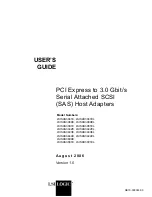
3
The Drivers for Windows
3.3.2.7 Disable Modem Ctrl At Startup
Usually on startup the modem control signals RTS
and DTR follow the behavior of standard ports (i.e. Com1). Due to the longer timing compared
to built-in serial ports a very short enable or disable pulse on the control signals may become a
comparably long pulse on the USB serial port. Such a long pulse can cause external hardware
to malfunction. By correct configuration of the serial port application software can avoid that
problem. However since it does not appear on Com1, most software does not care about that. This
option will help to “heal” such problem.
Note that if the "Serial Enumerator" option is enabled, in the enumeration sequence Windows causes
the control signals to change. So if it is necessary to select "Disable Modem Ctrl At Startup", it is
likely that "Serial Enumerator" should be disabled.
3.4 Optimizing Data Throughput
Roughly speaking, the USB allows one operation between Host PC and attached USB device per
millisecond. This is the basic reason why the Latency (see
3.3.2.1
) can’t be shorter than 1 ms. But
there is a second effect causing slow transmissions.
Many software sends the data to the driver byte-by-byte. This is not a problem with built-in ports
like Com1. Except for extreme high transmission rates the operation time of the driver is much
shorter than the serial transmission time. So when the second and following byte are sent to the
driver, the previous bytes did not completely leave the PC and its buffers. The serial port does not
run out of data.
This is different with USB serial ports. Now matter how fast the byte is transmitted over the USB
cable (12 Mbit/s or 48Mbit/s), it takes 1 ms to send the next byte. Calculated the other way
this is 1000 byte per second, which is equivalent to 9600 bit/s. The user feels the transmission as
sluggish. Raising the serial speed does not help, since this is not the problem.
However it requires nearly the same millisecond to send one byte or more. So if the application
sends complete buffers instead byte-by-byte, the driver can send more than one byte per millisecond.
This way the USB serial port is permanently fed with work to send.
June 2009
USB-COM PRO User Manual
18














































